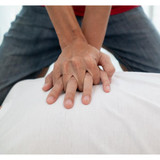Is a Zoll defibrillator biphasic or monophasic?
Zoll are a market-leaders in manufacturing medical products and software solutions to help clinicians, fire professionals, lay rescuers and the military. They develop products which are lifesaving and that advanced emergency care to save lives. Some of their products include; ventilators, automated CPR, temperature management, IPR therapy and defibrillators.
Defibrillators are life-saving medical devices that are used when someone suffers a sudden cardiac arrest. This occurs when there is an electrical problem with the heart which causes it to beat either too fast, too slow or to stop. A defibrillator works by scanning the heart’s electrical rhythm to determine whether a shock is required or not. If a shock is needed, a defibrillator will deliver this in order to stop the heart. The aim here is for the heart to then start beating at it’s natural pace again of it’s own accord.
After years of scientific research, defibrillators have proven to be exceptionally effective with the chances of survival being around 90% if used within the first minute of someone falling ill. If there is not a defibrillator present when someone suffers a sudden cardiac arrest, the chances of survival are unfortunately, very slim.
When it comes to defibrillators, you can get either biphasic or monophasic. A monophasic defibrillator delivers the electrical shock in a single direction through one electrode to another. With a biphasic shock however, the shock travels in two phases. In the first phase, the current runs from the first electrode to the second electrode via the person’s heart. Both are considered effective however, a biphasic shock is seen as more convenient, accurate and effective. It is also known to prevent further damage to the heart.
All Zoll defibrillators feature their proprietary Rectilinear Biphasic Waveform (RBW) technology. It is the only biphasic waveform that has demonstrated clinically superior results when compared to monophasic waveforms for:
- Cardio version of atrial fibrillation
- Defibrillation of ventricular fibrillation in high impedance patients
- Defibrillation of ventricular fibrillation in out-of-hospital cardiac arrest in an ACLS environment.
At 200 Joules, the ZOLL RBW delivers more average current to high impedance patients than any other biphasic waveform – even the defibrillators that have higher energy settings. Testing has shown that when compared to other defibrillators, at 200 joules, the Zoll RBW waveform delivers more average current at mid and high impedances. Continuous testing over 7,000 patients has proven that it is superior to monophasic and in the US, the high-current ZOLL bisphasic waveform is the only waveform approved by the US Food and Drug Administration.
ZOLL provide global users with a range of defibrillators including the R Series, X Series and X Series Monitor, not to mention their AED’s for professional rescuers and the public. We supply a wide range of ZOLL products, click here to shop them.
Recent Posts
-
What is CPR?
Knowing the basics of first aid and how to deliver CPR (cardiopulmonary resuscitation) can make the …17th Nov 2024 -
What is a sudden cardiac arrest (SCA)?
Sudden Cardiac Arrest (SCA) is a critical medical emergency where the heart abruptly ceases to funct …17th Nov 2024 -
Empowering Communities: The Lifesaving Impact of CPR on Restart a Heart Day
Every year, on and around October 16th, an important event takes place - Restart a Heart Day. This a …16th Oct 2023




